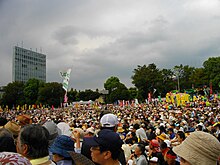Gerakan anti-nuklear



Gerakan anti-nuklear ialah gerakan sosial yang menentang pelbagai teknologi nuklear. Beberapa kumpulan tindakan langsung, gerakan alam sekitar dan organisasi profesional telah mengenal pasti diri mereka dengan pergerakan itu di peringkat tempatan, kebangsaan atau antarabangsa.[2][3] Kumpulan anti-nuklear utama termasuk Kempen untuk Perlucutan Senjata Nuklear, Sahabat Bumi, Greenpeace, Pakar Perubatan Antarabangsa untuk Pencegahan Perang Nuklear, Tindakan Keamanan dan Perkhidmatan Maklumat dan Sumber Nuklear. Objektif awal pergerakan itu adalah pelucutan senjata nuklear, walaupun sejak akhir 1960-an pembangkang telah memasukkan penggunaan tenaga nuklear. Banyak kumpulan anti-nuklear menentang kedua-dua kuasa nuklear dan senjata nuklear. Pembentukan parti hijau pada 1970-an dan 1980-an selalunya merupakan hasil langsung daripada politik anti-nuklear. [4]
Rujukan
[sunting | sunting sumber]- ^ Herbert P. Kitschelt. Political Opportunity and Political Protest: Anti-Nuclear Movements in Four Democracies British Journal of Political Science, Vol. 16, No. 1, 1986, p. 71.
- ^ Fox Butterfield. Professional Groups Flocking to Antinuclear Drive, The New York Times, 27 March 1982.
- ^ William A. Gamson and Andre Modigliani. Media Coverage and Public Opinion on Nuclear Power Diarkibkan 24 Mac 2012 di archive.today, American Journal of Sociology, Vol. 95, No. 1, July 1989, p. 7.
- ^ John Barry and E. Gene Frankland, International Encyclopedia of Environmental Politics, 2001, p. 24.
Bibliografi
[sunting | sunting sumber]- Brown, Jerry and Rinaldo Brutoco (1997). Profiles in Power: The Anti-nuclear Movement and the Dawn of the Solar Age, Twayne Publishers.
- Byrne, John and Steven M. Hoffman (1996). Governing the Atom: The Politics of Risk, Transaction Publishers.
- Clarfield, Gerald H. and William M. Wiecek (1984). Nuclear America: Military and Civilian Nuclear Power in the United States 1940–1980, Harper & Row.
- Cooke, Stephanie (2009). In Mortal Hands: A Cautionary History of the Nuclear Age, Black Inc.
- Cragin, Susan (2007). Nuclear Nebraska: The Remarkable Story of the Little County That Couldn’t Be Bought, AMACOM.
- Dickerson, Carrie B. and Patricia Lemon (1995). Black Fox: Aunt Carrie's War Against the Black Fox Nuclear Power Plant, Council Oak Publishing Company, ISBN 1-57178-009-2
- Diesendorf, Mark (2009). Climate Action: A Campaign Manual for Greenhouse Solutions, University of New South Wales Press.
- Diesendorf, Mark (2007). Greenhouse Solutions with Sustainable Energy, University of New South Wales Press.
- Elliott, David (2007). Nuclear or Not? Does Nuclear Power Have a Place in a Sustainable Energy Future?, Palgrave.
- Falk, Jim (1982). Global Fission: The Battle Over Nuclear Power, Oxford University Press.
- Fradkin, Philip L. (2004). Fallout: An American Nuclear Tragedy, University of Arizona Press.
- Giugni, Marco (2004). Social Protest and Policy Change: Ecology, Antinuclear, and Peace Movements in Comparative Perspective, Rowman and Littlefield.
- Lovins, Amory B. (1977). Soft Energy Paths: Towards a Durable Peace, Friends of the Earth International, ISBN 0-06-090653-7
- Lovins, Amory B. and John H. Price (1975). Non-Nuclear Futures: The Case for an Ethical Energy Strategy, Ballinger Publishing Company, 1975, ISBN 0-88410-602-0
- Lowe, Ian (2007). Reaction Time: Climate Change and the Nuclear Option, Quarterly Essay.
- McCafferty, David P. (1991). The Politics of Nuclear Power: A History of the Shoreham Power Plant, Kluwer.
- McKay, George (2019) '"They've got a bomb": sounding anti-nuclearism in the anarcho-punk movement in Britain, 1978-84.' Rock Music Studies 6(2): 1-20.
- McKay, George (2021) 'Rethinking the cultural politics of punk: anti-nuclear and anti-war (post-)punk popular music in 1980s Britain.' In George McKay and Gina Arnold, eds. The Oxford Handbook of Punk Rock. New York: Oxford University Press.
- Natti, Susanna and Bonnie Acker (1979). No Nukes: Everyone's Guide to Nuclear Power, South End Press.
- Newtan, Samuel Upton (2007). Nuclear War 1 and Other Major Nuclear Disasters of the 20th Century, AuthorHouse.
- Ondaatje, Elizabeth H. (c1988). Trends in Antinuclear Protests in the United States, 1984–1987, Rand Corporation.
- Parkinson, Alan (2007). Maralinga: Australia’s Nuclear Waste Cover-up, ABC Books.
- Pernick, Ron and Clint Wilder (2012). Clean Tech Nation: How the U.S. Can Lead in the New Global Economy.
- Peterson, Christian (2003). Ronald Reagan and Antinuclear Movements in the United States and Western Europe, 1981–1987, Edwin Mellen Press.
- Price, Jerome (1982). The Antinuclear Movement, Twayne Publishers.
- Rudig, Wolfgang (1990). Anti-nuclear Movements: A World Survey of Opposition to Nuclear Energy, Longman.
- Schneider, Mycle, Steve Thomas, Antony Froggatt, Doug Koplow (August 2009). The World Nuclear Industry Status Report, German Federal Ministry of Environment, Nature Conservation and Reactor Safety.
- Smith, Jennifer (Editor), (2002). The Antinuclear Movement, Cengage Gale.
- Sovacool, Benjamin K. (2011). Contesting the Future of Nuclear Power: A Critical Global Assessment of Atomic Energy, World Scientific.
- Surbrug, Robert (2009). Beyond Vietnam: The Politics of Protest in Massachusetts, 1974–1990, University of Massachusetts Press.
- Walker, J. Samuel (2004). Three Mile Island: A Nuclear Crisis in Historical Perspective, University of California Press.
- Wellock, Thomas R. (1998). Critical Masses: Opposition to Nuclear Power in California, 1958–1978, The University of Wisconsin Press, ISBN 0-299-15850-0
- Wills, John (2006). Conservation Fallout: Nuclear Protest at Diablo Canyon, University of Nevada Press.
- Wittner, Lawrence S. (2009). Confronting the Bomb: A Short History of the World Nuclear Disarmament Movement, Stanford University Press.
Pautan luar
[sunting | sunting sumber]| Wikimedia Commons mempunyai media berkaitan Gerakan anti-nuklear |
- The M and S Collection at the Library of Congress contains anti-nuclear movement materials.
